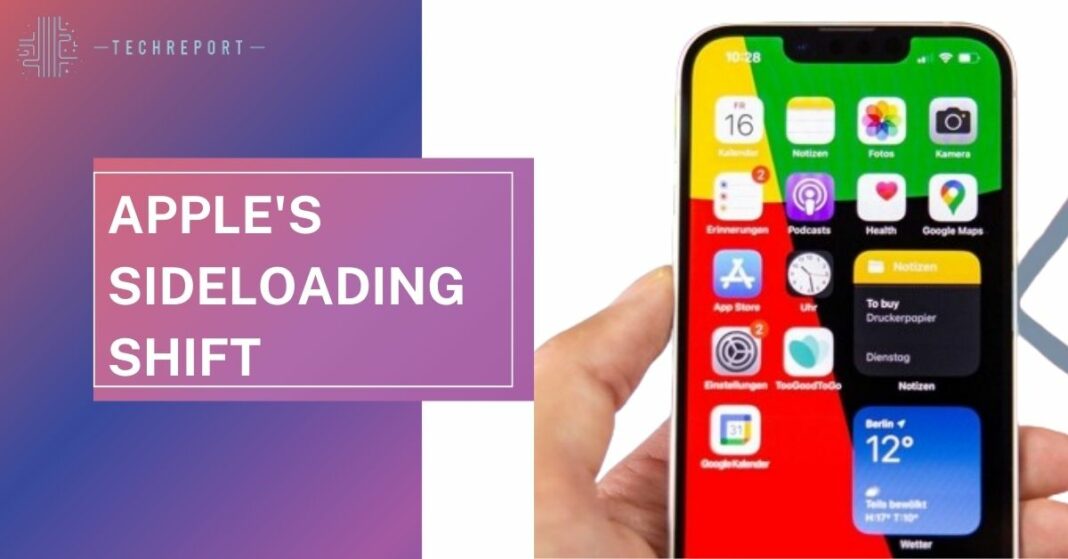Sideloading, a term often heard in the tech world, refers to the process of installing apps on a device from sources outside the official app store. For Apple users, this has been a restricted territory, a stance rooted in the company’s history of tightly controlling its ecosystem.
In the past, Apple staunchly upheld its closed ecosystem, allowing app installations only through its App Store. This approach, while ensuring a controlled and secure environment, limited user flexibility. Sideloading, or the ability to install apps from alternative sources, was a practice deemed incompatible with Apple’s guidelines.
Enter the European Union’s Digital Markets Act, a game-changer in the tech landscape. This regulation demands gatekeeper companies, including Apple, to open up their software ecosystems by March 2024. This directive has prompted Apple to reconsider its stance on sideloading, hinting at potential changes in the near future.
As we delve into this evolution, we’ll explore the implications of sideloading on Apple devices and how the EU’s push for openness is reshaping the tech giant’s policies.
Also Read: How to Take Screenshot on Apple Watch
EU Regulations and Apple’s Response

The European Union’s Digital Markets Act has emerged as a pivotal force shaping the tech industry. This regulatory framework specifically targets gatekeeper companies, placing a demand for increased openness within their software ecosystems. Apple, a prominent player in this space, is under the spotlight as the EU aims to foster competition and user choice.
Apple’s Financial Filings and Preparations
In response to the EU’s directive, Apple has taken strategic measures, evident in recent financial filings. These documents provide insights into the company’s preparations for complying with the upcoming changes. As the tech giant navigates this landscape, financial transparency becomes crucial, reflecting the magnitude of adjustments required.
Anticipation of Sideload Changes by March 2024
The EU’s Digital Markets Act sets a deadline, compelling gatekeeper companies like Apple to implement the mandated changes by March 2024. This looming deadline creates a sense of anticipation and urgency. Apple users, developers, and industry observers are keenly watching for the unfolding of modifications in sideloading policies, a shift poised to impact the iOS ecosystem significantly.
Stay tuned as we unravel the intricacies of how the EU’s regulatory landscape is influencing Apple’s response and the expected alterations in sideloading dynamics by March 2024.
Apple’s Policy Evolution
To understand Apple’s current policy landscape, we delve into its historical context. The tech giant has long upheld a reputation for stringent control over its ecosystem. This approach, while fostering a secure environment, has often limited the freedom users and developers have in choosing and distributing applications.
Reports on Potential Changes with iOS 17
Recent industry reports have sparked discussions about a potential shift in Apple’s policy landscape with the advent of iOS 17. The company seems to be reevaluating its stance, considering adjustments that could mark a departure from the traditionally rigid policies. These reports serve as a beacon of change, hinting at a more flexible approach towards app installations.
Implications for Users and Developers
Such policy evolution carries significant implications for both users and developers within the Apple ecosystem. Users may experience newfound flexibility in choosing apps, while developers might find a more open environment to innovate and distribute their creations. As we explore these implications, it becomes clear that changes in Apple’s policies resonate across its vast user and developer communities.
Join us in unraveling the nuances of Apple’s policy evolution, gaining insights into how these potential changes with iOS 17 might shape the experiences of users and developers alike.
Also Read: Delete Apps on Chromebook
Apple’s Security Concerns
Quoting Apple’s Head of Security sheds light on the tech giant’s perspective on sideloading and the associated security landscape. These insights provide a glimpse into the considerations that drive Apple’s cautious approach, emphasizing the company’s commitment to maintaining a secure digital environment for its users.
Understanding Security Threats Tied to Sideloading
Delving deeper, it’s crucial to understand the security threats linked to sideloading. Sideloading, the installation of apps from external sources, opens avenues for potential malware and security vulnerabilities. This section breaks down the intricacies of these threats, offering a simplified understanding of the risks users might encounter when deviating from the App Store.
EU’s Stance on User Protection and Apple’s Response
As the EU champions user protection, we explore how their stance aligns with Apple’s response to security concerns. This section unveils the intersection between regulatory expectations and Apple’s commitment to user safety. By examining this dynamic, we gain insights into the delicate balance between user freedom and the imperative to maintain a secure digital environment.
Stay tuned to unravel the intricate dance between security concerns, regulatory expectations, and Apple’s unwavering commitment to user protection in the ever-evolving landscape of sideloading.
Impact on App Developers and Users
As the tide of change approaches, app developers find themselves at the forefront of adapting to evolving policies. This section delves into the strategies and responses from the developer community, exploring how they are navigating the potential transformations in the app landscape. Insights into their approaches shed light on the broader impact on the app ecosystem.
User Concerns: Unpacking Expectations and Apprehensions
In tandem with developer responses, this segment addresses the concerns and expectations bubbling within the user community. Users play a pivotal role in the success of any platform, and understanding their worries and expectations provides a holistic view of the repercussions of policy shifts. By dissecting these concerns, we aim to offer a comprehensive perspective on how users anticipate and brace for the impending changes.
The impact on both app developers and users is a crucial aspect of the evolving sideloading landscape. Join us as we uncover the multifaceted responses from the developer community and delve into the spectrum of concerns and expectations shaping the user experience in this transformative phase.
Potential Changes to Apple’s Ecosystem
The prospect of sideloading introduces a wave of speculation on how it might reshape the Apple ecosystem. This section delves into various scenarios, exploring the potential impacts on user experiences, app diversity, and overall ecosystem dynamics. By navigating through these speculations, we aim to paint a picture of the potential transformations awaiting Apple’s digital domain.
Striking a Balance: User Freedom vs. Apple’s Control
Central to this exploration is the delicate balance between user freedom and Apple’s longstanding control over its ecosystem. As sideloading introduces new dynamics, the challenge lies in maintaining a harmonious equilibrium. Unpacking this balance sheds light on how Apple aims to adapt to changing user expectations while safeguarding the principles that define its digital environment.
Join us as we embark on a journey of speculation, dissecting potential changes to the Apple ecosystem with the advent of sideloading. In navigating this uncharted territory, the quest for equilibrium between user freedom and Apple’s control takes center stage, shaping the narrative of the Apple experience in the evolving tech landscape.
Also Read: How to Delete Spotify History
In Crux
As we reach the culmination of our exploration, a brief recap reinforces the key points that have unfolded. From Apple’s historical stance on sideloading to the EU’s regulatory intervention, each element contributes to the evolving narrative of sideloading within the Apple ecosystem.
The significance of EU regulations emerges as a pivotal force shaping Apple’s policies. This section revisits the impact of the Digital Markets Act, highlighting its role in instigating changes within one of the tech industry’s giants. The EU’s push for openness stands as a testament to the transformative power of regulatory frameworks in shaping digital landscapes.
As the narrative unfolds, anticipation builds around the imminent changes and their potential impact on user experience. This section explores the expectations and apprehensions surrounding sideloading, offering a glimpse into the future landscape of Apple’s digital domain. The evolving dynamics between user freedom and the tech giant’s control add a layer of complexity to this anticipation.
In concluding this journey through the sideloading saga, we reflect on the key points, acknowledge the transformative force of EU regulations, and look forward to the unfolding chapters that will shape the user experience within the Apple ecosystem. Stay tuned for further updates on this ever-evolving tech narrative.
How much did you like Our Detailed Apple’s Sideloading Shift: EU Influence”? Review Also, please share these Blogs with your friends on social media.
Related Blogs
- Is iPhone 14 Worth the Hype
- Unblock Banned Apps
- Best Cheap VPN Services
- Curved or Flat: Which TV Should You Buy?
FAQs about Apple’s Sideloading Shift
How do EU regulations impact Apple's sideloading policies?
The European Union's Digital Markets Act places a spotlight on gatekeeper companies like Apple, urging them to open up their software ecosystems by March 2024. Apple's financial filings and preparations hint at a forthcoming allowance for sideloading on iPhones, marking a significant shift in policy. The EU's role becomes pivotal in reshaping Apple's approach, emphasizing the regulatory influence on major industry players.
What security concerns are associated with sideloading on Apple devices?
Apple's Head of Security emphasizes that sideloading poses security threats, exposing devices to potential malware. The closed nature of Apple's ecosystem aims to safeguard users from such risks. The EU's focus on user protection prompts Apple to balance security concerns with user freedom, revealing the intricate interplay between regulatory expectations and maintaining a secure digital environment.
How are app developers responding to potential changes in sideloading policies?
App developers find themselves at the forefront of adapting to potential sideloading policy changes. Strategies and responses from the developer community vary, reflecting the broader impact on the app ecosystem. The developer perspective becomes crucial in understanding the ripple effects of policy shifts, showcasing the dynamic nature of the tech landscape.
What can users expect regarding the impact on their experience with Apple devices?
Users anticipate significant changes in their experience with Apple devices, considering the potential introduction of sideloading. The balance between user freedom and Apple's control becomes a focal point, raising expectations and concerns among the user community. Navigating this transformative phase requires a nuanced understanding of evolving policies and their repercussions on the user experience within the Apple ecosystem.




























